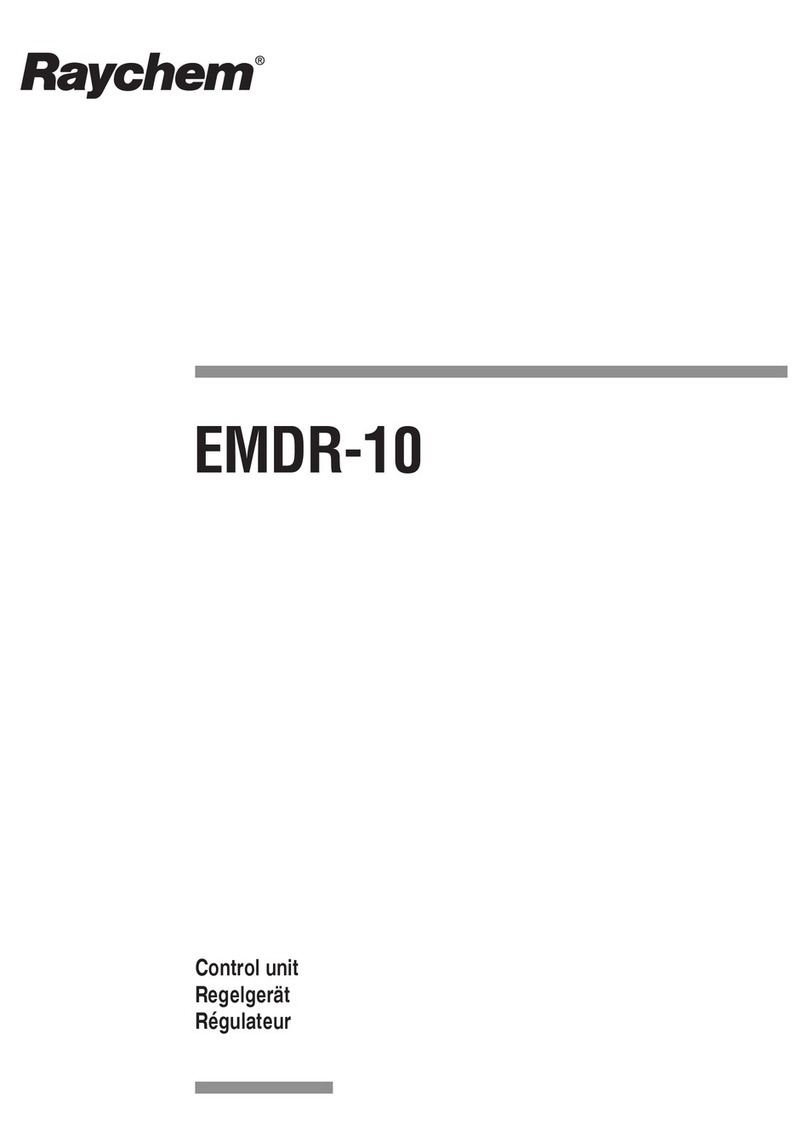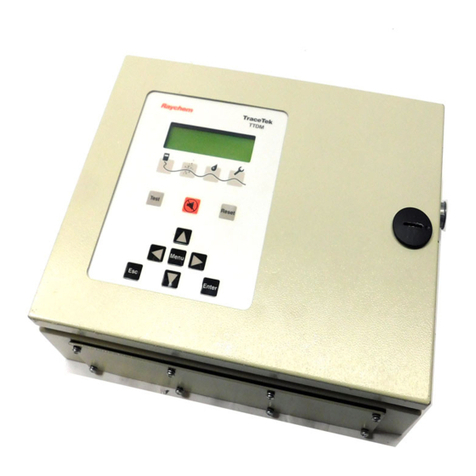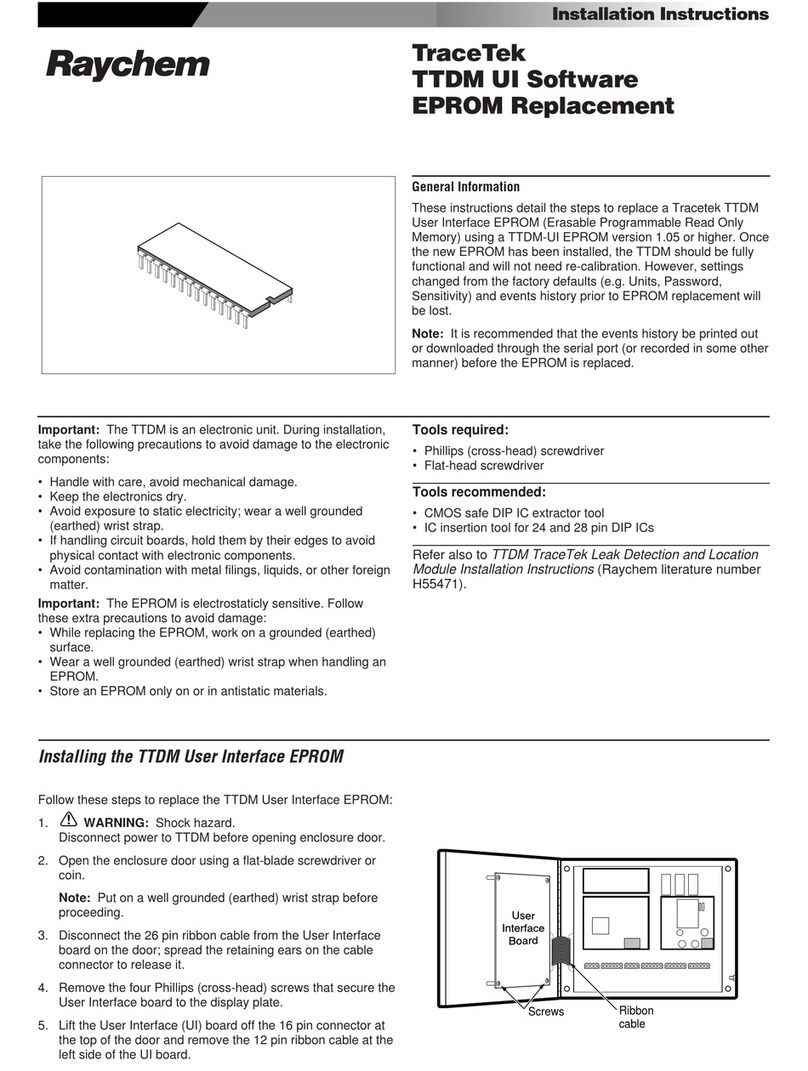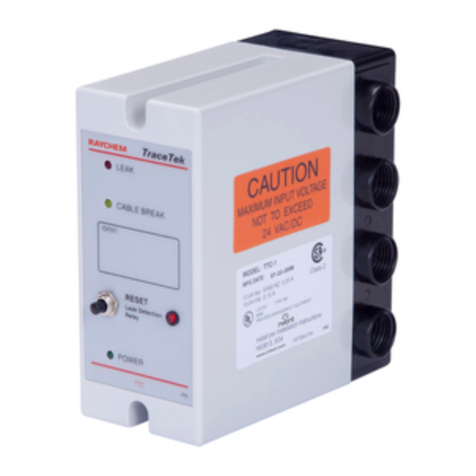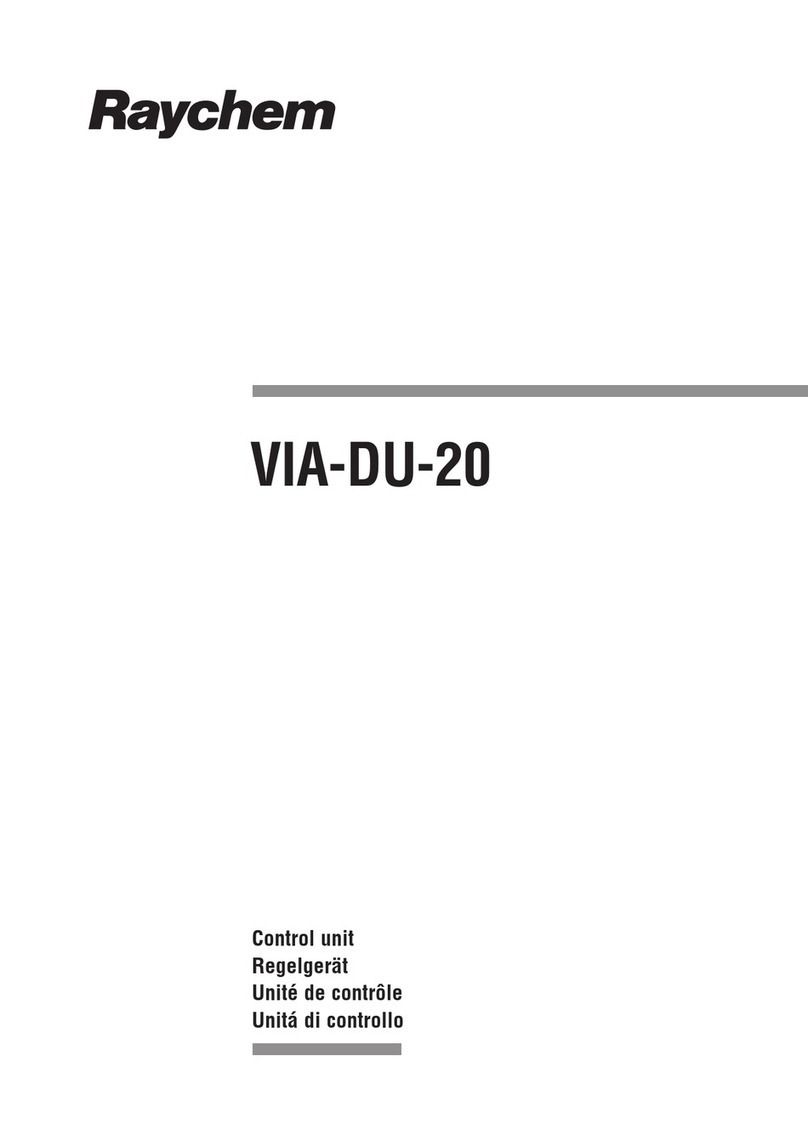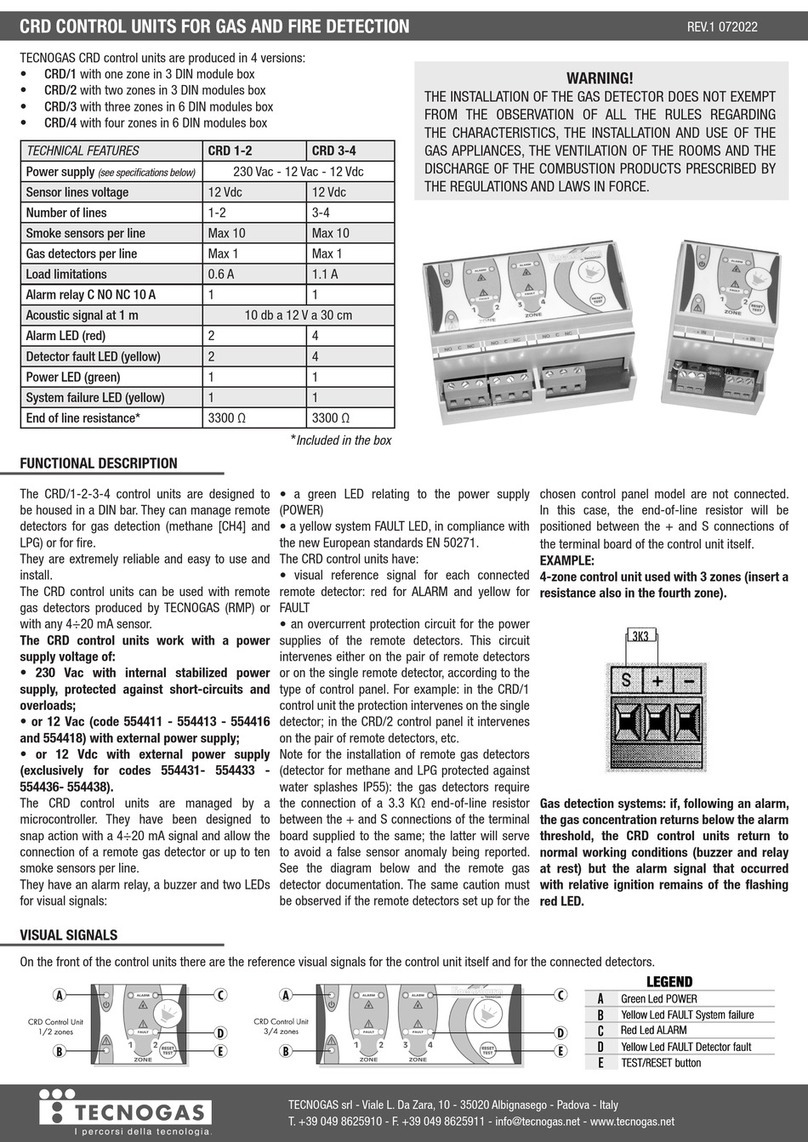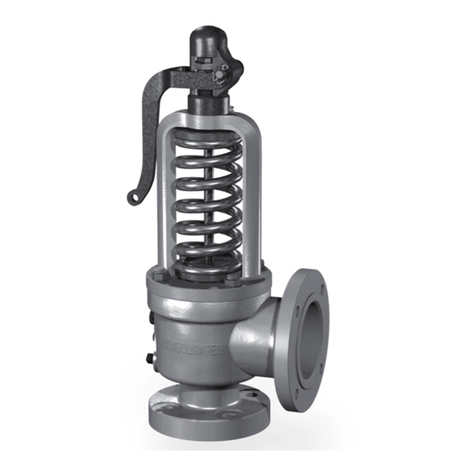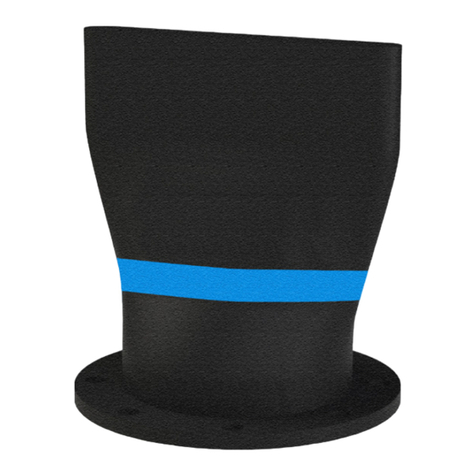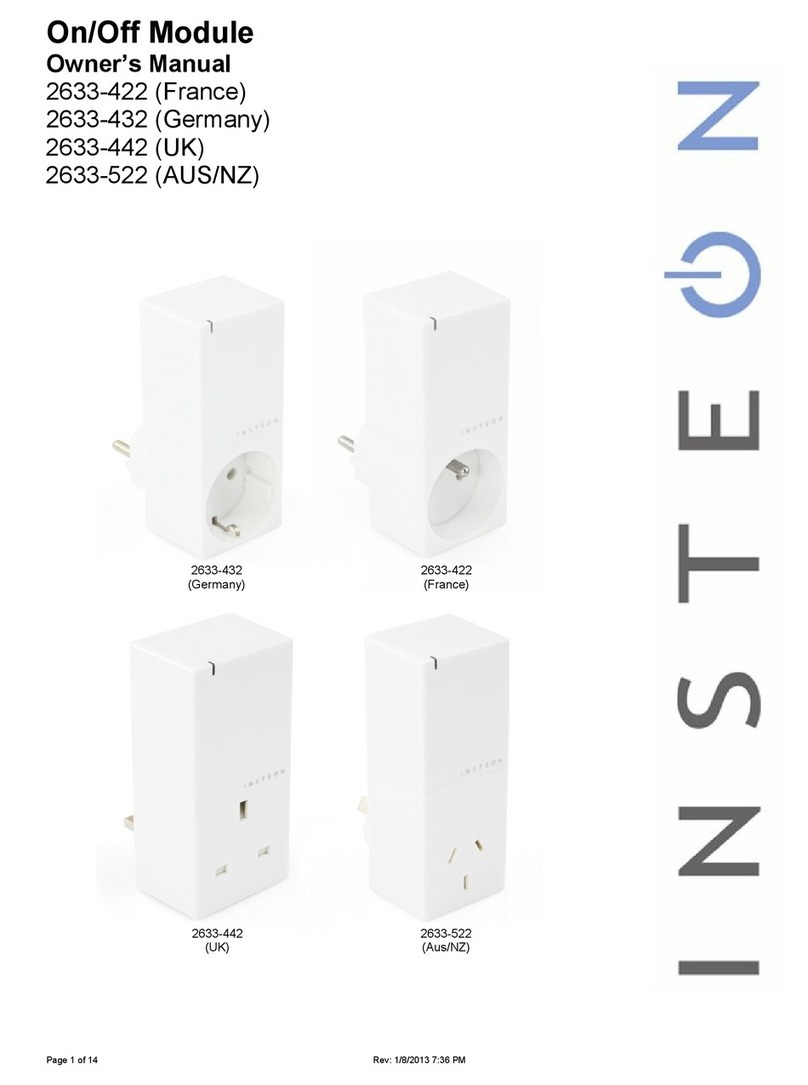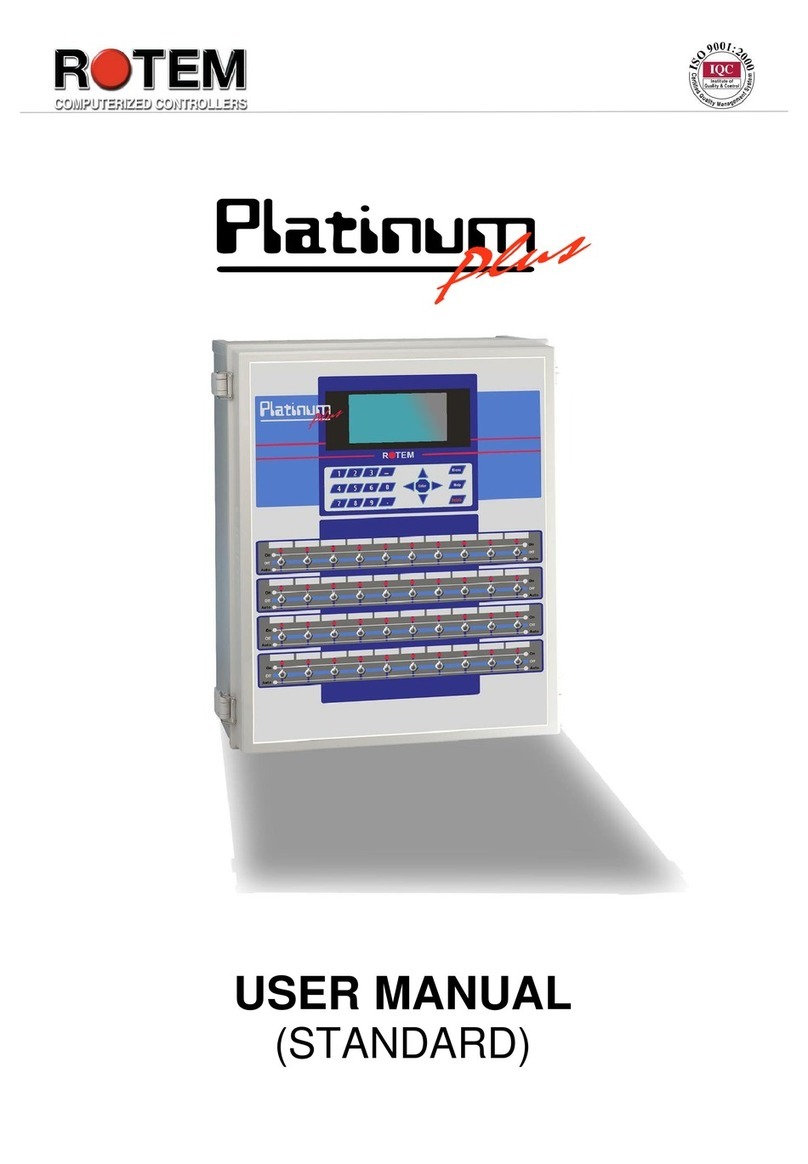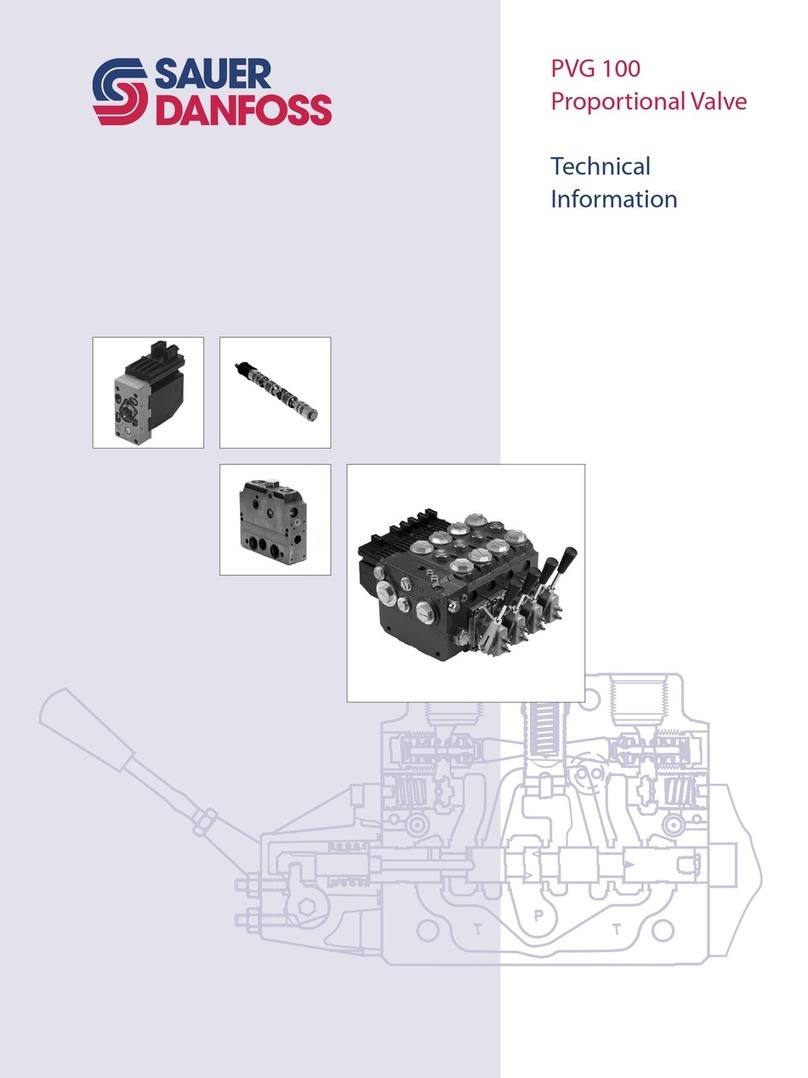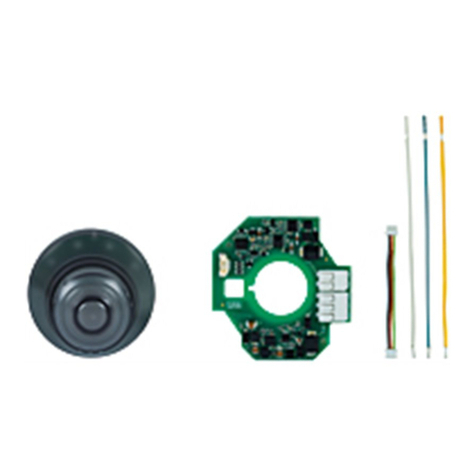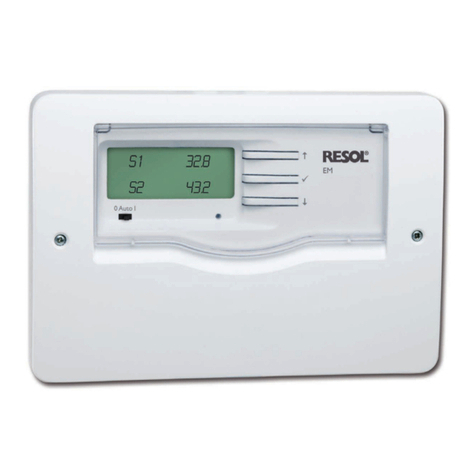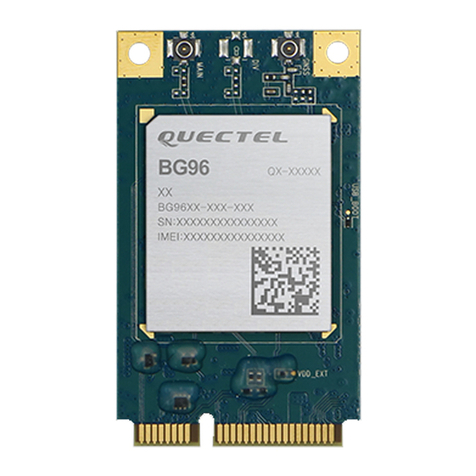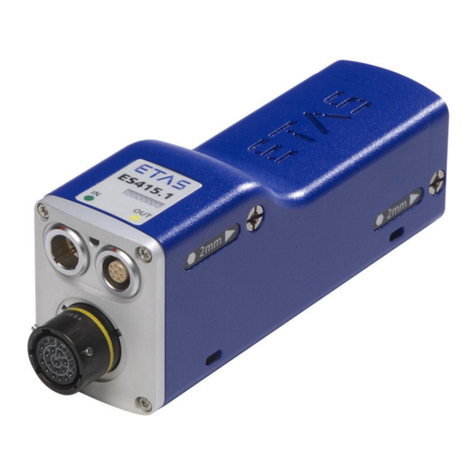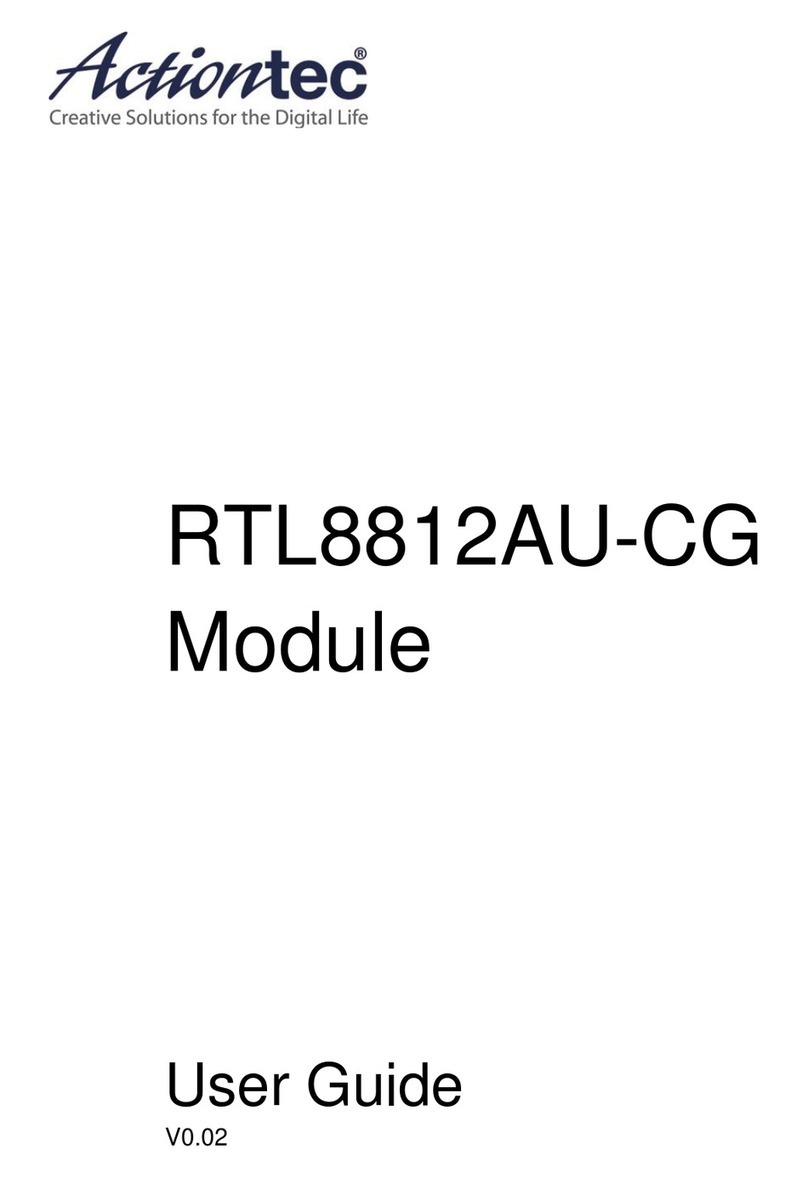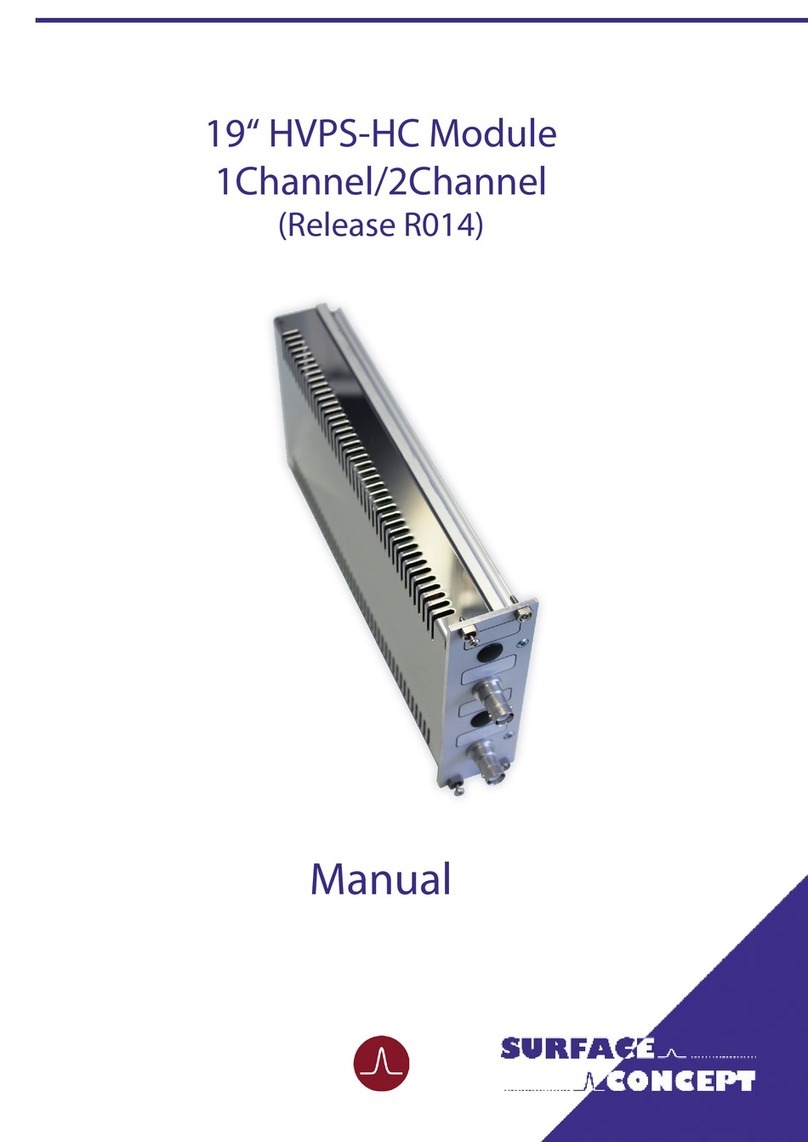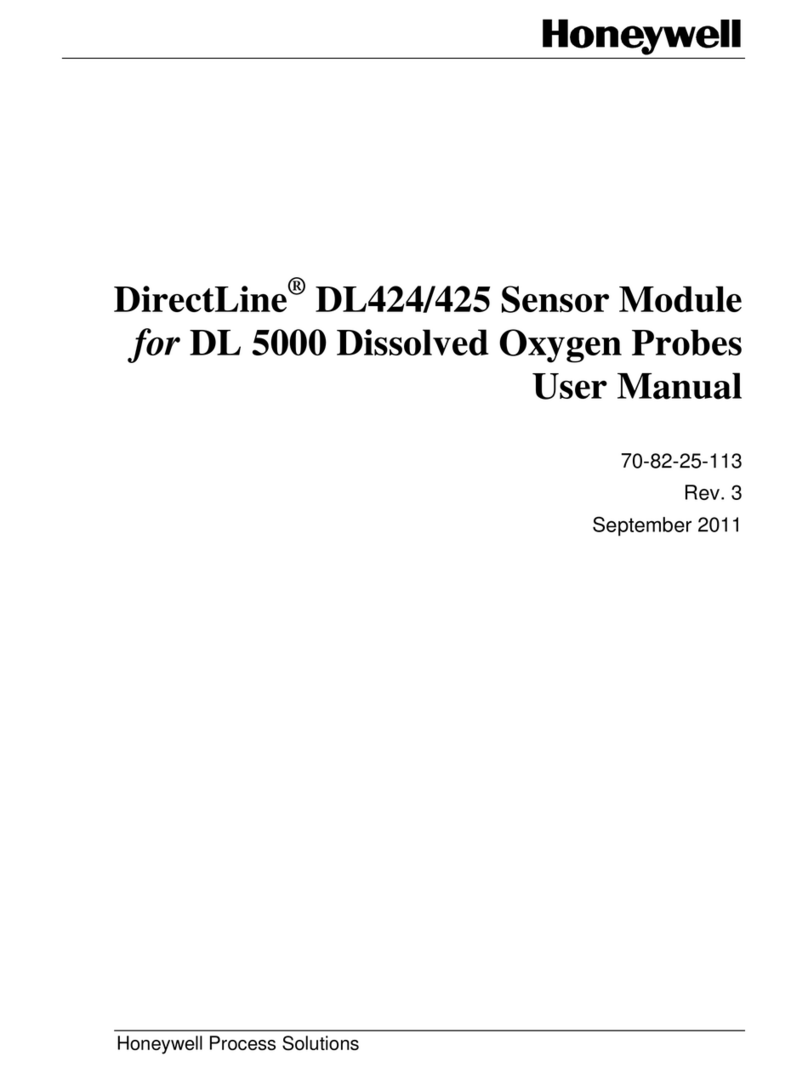Raychem nVent RMM2-E User manual

RMM2-E
TRACE-HEATING REMOTE MONITORING MODULE
EXTERNES BEHEIZUNGS-ÜBERWACHUNGSMODUL
MODULE DE SURVEILLANCE À DISTANCE POUR TRAÇAGE ÉLECTRIQUE
МОДУЛЬ ДИСТАНЦИОННОГО КОНТРОЛЯ ЭЛЕКТРООБОГРЕВА

C |nVent.com
INSTALLATION INSTRUCTIONS
Description
The nVent RAYCHEM Remote Monitoring
Module (RMM2-E) is part of the RAYCHEM NGC
control and monitoring system. The RMM2-E
accepts inputs from up to 8 RTDs (3 wire Pt 100
temperature sensors) measuring pipe or ambient
temperature in a trace heating system.
Up to 16 RMM2-E units communicate with a
RAYCHEM NGC-30 or NGC-40 controller using
a single RS-485 cable.
For technical assistance, call your local nVent
representative or the nVent service center listed
on the last page.
Parts (supplied)
RMM2-E without enclosure
• RMM2-E Trace-heating Remote Monitoring
Module
• Replacement fuses
• Jumper for voltage selection
• Label
Hazardous Area Unit (RMM2-EX-E)
• RMM2-EX-E Trace-heating Remote
Monitoring Module
• Exn R II T6 glassfibre-reinforced polyester
enclosure
• 12 Ex e M20 glands for power cable
(6 to 12 mm cable diameter) with mushroom
stopping plugs
• Replacement fuses
• Jumper for voltage selection
WARNING:
This component is an electrical device. It must be
installed correctly to ensure proper operation and
to prevent frozen pipes, shock or fire. Read and
carefully follow all the installation instructions.
Approvals
RMM2-EX-E:
Hazardous Areas
II 3 G/D T=70°C EExn R II T6
(Ta –20°C to +60°C)
Baseefa03ATEX0739
TC RU C-BE.ИМ43.B.01764
2Ex nR II T6 Gc IP66
Ta -55°C…+60°C
ООО “ТехИмпорт”
Special conditions for safe use:
All unused entry holes must be sealed using the
scheduled cable gland and stopping plug.
Consider the effects of direct heating on the
exterior of the enclosure and the impact this may
have on the internal temperature rise.
Non-Hazardous Areas
RTD and RS-485 circuitry
are isolated from power
mains circuitry by protective
separation.
Tools Required
• 7 mm flat-blade screwdriver
• 3 mm flat-blade screwdriver
• wire stripper/cutter
• 27 mm spanner (for M20 glands)

nVent.com |3
Specifications
Supply voltage (nominal): 115/230 Vac, ±10%, jumper selectable, 50/60 Hz
Power consumption: 2,5 VA
Ambient operating range: –40°C to +60°C
–20°C to +60°C (Exn enclosure and glands)
Relative humidity: 5 to 95%, noncondensing
Temperature sensors: 3-wire RTD (Pt 100)
Temperature coefficient: per IEC 751-1983 (100 Ω at 0°C)
Sensor connections: Can be extended with a 3-core shielded cable of 20 Ω max. per
conductor (e.g., 150 m with 3 x 1.5 mm2 cable)
RS-485 connections: Shielded, single twisted pair, max. 1200 m
Replaceable fuse: F 200 mA/250 V, Wickmann part number 19370-034-K (FAST BLOW)
Installation materials (not supplied)
Fasteners
4 screws for 6.5 mm holes for mounting enclosures
Pt 100 temperature sensors (RTDs)
MONI-PT100-NH Temperature sensor for non-hazardous areas with M20 cable gland
MONI-PT100-EXE Temperature sensor for hazardous areas
Remote Monitoring Module (RMM2-E)
1Fuse (200 mA, 250V)
2Terminals for power input with provision for
daisy chaining
3Voltage selector jumpers
4Terminals for RS-485 bus
5LEDs which indicate communications
activity
6LED which indicates power to the
RMM2-Eunit
7Rotary switch (16 position) to assign
RS-485address
8Terminals for RTD lead wires
9Shorting block to select RS-485
terminationmode
60 mm
42 mm
15
mm
75 mm
125 mm
0
Install per nVent RMM2 Instructions Manual nVent Montage- und
Betriebsanleitung beachten Suivre attentivement les intructions
d’installation de nVent
60 mm
42 mm
15
mm
75 mm
125 mm
0
Install per nVent RMM2 Instructions Manual nVent Montage- und
Betriebsanleitung beachten Suivre attentivement les intructions
d’installation de nVent
1
23 4
5
6
7
8
9

C |nVent.com
Overview of Installation Procedure for the RMM2-EX-E
A. Mount RMM2-EX-E enclosure and install cables.
B. Connect power and earth wiring and select voltage operating range.
C. Connect RTD cables to the RMM2-EX-E.
D. Select RS-485 address for the RMM2-EX-E and connect the RS-485 bus cables.
Note: Installation to be performed by suitable trained personnel.
Note: Keep the Remote Monitoring Module clean and dry prior to installation to avoid damage to
internal components.
Note: When RMM2-E is used for DIN-rail installation in a local customised panel or enclosure,
must be added 10 earth terminals for earthing of RTD’s and power cables. Terminals should
accept wires from 0.2 to 4 mm2.
A. Mount Enclosure and Install Cables
1. Select a suitable location for the
RMM2-EX-E enclosure.
The enclosure is suitable for use in Zone 2 areas.
Do not mount in Zone 1 or Zone 0 areas. For
installations in Zone 1 areas, contact nVent.
Use the dimensions to locate mounting holes
for the enclosure. Mount the enclosure using
suitable screws (hole diameter 6 mm).
2. Install cables
Install power cable(s), RS-485 cable(s) and RTD
cables into enclosure using glands supplied.
Keep stopping plugs in unused entries.
0
91
160 110
260
240 6.5
0

nVent.com |5
B. Connect Power and Earth Wiring and
Select Voltage Operating Range
3. Select the voltage operating range
Connect the supplied wire jumpers to the
appropriate terminals to select input voltage.
The RMM2-E is supplied jumpered for 230 volts.
4. Connect wiring from power source to
designated terminals on RMM2-E.
Use only copper conductors. Connect power
cable wires to the terminals marked L1 and L2 on
the RMM2-E. If power is being daisy chained, be
sure to maintain polarity of L1 and L2 wiring for
incoming and outgoing wires.
The terminals accept stranded wires from
0.2 – 2,5 mm2. (0,2 - 4 mm2solid wire)
5. Connect earth wiring.
Connect the earth wire(s) to the earth terminals
mounted on the DIN rail. The terminals accept 0,8
- 2,5 mm2 solid or stranded wires.
Jumpered
for 115V
Jumpered
for 230V
0
2
0
3

C |nVent.com
C. Connect RTD Cables to the RMM2-E
The RMM2-E has terminals for 8 three-wire, RTDs
(Pt 100 temperature sensors, to IEC 751); do not
use other types of RTDs. Select RTDs appropriate
for the usage:
MONI-PT100-NH Temperature sensor for
non-hazardous areas
MONI-PT100-EXE Temperature sensor for
hazardous areas
Install each RTD in accordance with the
installation instructions shipped with it, and run
the RTD lead wires to the RMM2-E.
Note: Resistance of lead wires from each RTD
must not exceed 20 Ω (e.g. 150 m with
3 x 1,5 mm2cable).
0
8
RMM2-E
terminal no.
1
2
3
4
5
6
7
8
Piping drawing
identification Description or location
6. Connect lead wires from each RTD to the
selected RMM2-E terminal block
The RMM2-E has 8 terminal blocks to connect
lead wires from 8 RTDs. Each RTD connection
is numbered; the number identifies the RTD, and
determines the order in which the RAYCHEM
NGC system displays the RTD measurement.
Therefore, order the RTD connections in a manner
that makes the RAYCHEM NGC system display
most meaningful.
The RMM2-E cover shows the correct wiring
arrangement for the RTD wires. With RAYCHEM
RTDs, connect the two RTD lead wires of the
same colour to the terminals marked “-“ and
connect the RTD lead wire that is a different
colour to the + terminal.
7. If RTD-shield is not earthed elsewhere,
connect shield to earth terminal.
8. Record the location/identification for
eachRTD.
Because the RMM2-E terminal connection
number identifies the RTD in the RAYCHEM
NGC system, it is important to record the
location of each RTD. Use the space below to
record the connections, and label the RMM2-E
or its enclosure with this RTD identification
information.

nVent.com |7
D. Select RS-485 Address and Connect the
RS-485 Bus Cables
9. Select the RS-485 address for the
RMM2-Eunit.
Each RMM2-E connected to a RAYCHEM NGC
control and monitoring system must have a
unique address; if two RMM2-E’s are assigned the
same address, communication faults will result.
To ensure that you assign a unique address to
each RMM2-E unit, do the following:
• Review the RAYCHEM NGC system layout; if a
layout document does not exist, create one. If
it has not already been done, assign an RS-485
address to each RMM2-E (up to 16) connected
to the RAYCHEM NGC system.
• If you are adding one or more RMM2-E units to
an existing RAYCHEM NGC network, confirm
that the RS-485 addresses for existing RMM2-E
units correspond to the system layout. See
for details the programming guide of the
RAYCHEM NGC system.
By checking the RS-485 addresses on an existing
system, you can avoid potential conflicts that
would be confusing and time consuming to
troubleshoot otherwise.
Record the RS-485 address selected for the
Remote Monitoring Module you are currently
installing, and label the exterior of the enclosure
with the address assigned to the RMM2-E.
For reference, here are the 16 possible RS-485
addresses: (0 -15 HEXADECIMAL)
0 1 2 3 4 5 6 7
8 9 A B C D E F
10. Set the RS-485 address for the RMM2-E unit
using the rotary switch provided
Take of the lid and use a flat-blade screwdriver to
rotate the RS-485 address switch to the desired
position. The single character visible on the
switch indicates the RS-485 address assigned.
0
7
6
0
11. Connect the RS-485 bus
Note: Do not make connections to the RS-485
bus while it is connected to an operating
RAYCHEM NGC network. Damage and/or alarms
could result.
The RS-485 bus allows units with unique
addresses to be connected together along a
common bus. To add a new unit to the network,
simply connect the RS-485 bus from the last unit
to the new one, or insert the new unit between
two existing units on the bus. The order in which
units are attached to the RS-485 bus does not
matter. There are just two constraints on the
RS-485 network:
• Each RMM2-E must be assigned a unique
address
• The RS-485 bus must be a continuous string
from the first network device to the last
RMM2-E in the system.
Note: The RS-485 bus operates at 5 V, and
equipment connected to it could be damaged by
exposure to higher voltages. Take precautions to
avoid exposing the RS-485 wiring to discharge of
static electricity or other sources of high voltage
potential; in particular, avoid contact with the
power supply wiring.

C |nVent.com
The RMM2-E has two sets of terminals for
connections to the RS-485 bus. One terminal
block allows the RMM2-E to connect to the
RS-485 bus, the second allows a continuation of
the bus to other RMM2-E units on the network.
Observe polarity, which is indicated on the
RMM2-E. Connect the incoming RS-485 bus to
the set of terminals marked “IN”, observing the
polarity noted on the cover of the RMM2-E; use
the terminal marked “S” for the shield of the
RS-485 cable. Connect the continuation
of the RS-485 bus to the set of terminals marked
“OUT” in the same manner (not required for the
last RMM2-E in the network).
Important: Do not connect the shield of the
RS-485 cables to the enclosure’s grounding
terminal. Connect the shield only to the RMM2-E
terminals provided. To avoid the potential
for spurious ground loops, the RS-485 cable
shield should be connected to ground only in
the RAYCHEM unit. For the last RMM2-E in the
network, terminate the RS-485 bus by removing
the shorting block on jumper location J17 from
2–3 and placing it across pins 1–2.
OR
NGC-30 via UIT2 NGC-40 via Bridge module

nVent.com |9

C |nVent.com
MONTAGEANLEITUNG
Beschreibung
Das nVent RAYCHEM Überwachungsmodul
(RMM2-E) ist Teil des RAYCHEM NGC Steuer-,
Regel- und Überwachungssystems. An ein
RMM2-E können bis zu 8 Widerstands-
Temperatursensoren (Pt 100- Sensor in 3-Leiter-
Technik) angeschlossen werden, welche die
Temperaturen der beheizten Oberflächen oder
die Umgebungstemperaturen im Heizsystem
erfassen. Das Steuer- und Überwachungsgerät
RAYCHEM NGC-30 oder NGC-40 kann mit bis
zu 16 RMM2-E-Modulen über ein RS-485-Kabel
kommunizieren.
Wenden Sie sich für weitere technische
Unterstützung wenden Sie sich bitte an die für Sie
zuständige nVent-Vertretung.
Lieferumfang
RMM2-E (ohne Zusatzgehäuse, für den Nicht-
Ex-Bereich)
• RMM2-E Externes Beheizungs-Überwachungs-
modul
• Ersatzsicherungen
• Brücken (Jumper) für Spannungswahl
• Aufkleber
RMM2-EX-E (mit Zusatzgehäuse, für
Ex-Bereiche)
• RMM2-EX-E Externes Beheizungs-
Überwachungsmodul
• EExn R II T6 glasfaserverstärktes
Polyester-Gehäuse
• 12 Stück M20 Kabelverschraubungen in
Eex e-Ausführung mit Blindstopfen
(für Netzkabel, RS-485-Leitung
und Sensorleitungen, 6-12 mm
Leitungsdurchmesser)
• Ersatzsicherungen
• Brücken (Jumper) für Spannungswahl
WARNUNG:
Bei diesem Gerät handelt es sich um eine
elektrische Vorrichtung. Für den einwandfreien
Betrieb und zur Vermeidung gefrorener
Rohrleitungen, elektrischer Schläge oder
Brände muss das Gerät fachgerecht installiert
werden. Lesen Sie alle Installationsanweisungen
sorgfältig durch und befolgen Sie diese.
Zulassungen
RMM2-EX-E:
Ex-Bereiche:
II 3 G/D T=70°C EExn R II T6
(Ta –20°C to +60°C)
Baseefa03ATEX0739
TC RU C-BE.ИМ43.B.01764
2Ex nR II T6 Gc IP66
Ta -55°C…+60°C
ООО “ТехИмпорт”
Besondere Bedingungen für den
sicherenEinsatz:
Alle nicht verwendeten Öffnungen müssen
mithilfe der vorgesehenen Kabelverschraubung
und des Blindstopfens verschlossen werden.
Auch ein potenzieller Temperaturanstieg
im Gehäuseinneren aufgrund direkter
Wärmeeinwirkung auf die Gehäuseaußenseite
muss berücksichtigt werden.
Non-Hazardous Areas
Die Sensor- und RS-485
Stromkreise sind von den
Netzstromkreisen durch
Schutzvorrichtungen getrennt.
Erforderliches Werkzeug
• 3 mm Schlitz-Schraubendreher
• 7 mm Längsschlitz-schraubendreher
• Abisolierzange/Cutter
• 27 mm Maulschlüssel
(für M20 Verschraubungen)

nVent.com |11
Technische Daten
Betriebsspannung: AC 115/230 V, +/- 10%, 50/60 Hz, mit Brücke (Jumper)
wählbar 50/60 Hz
Eigenverbrauch / Nennleistung: 2,5 VA
Einsatztemperaturbereich: –40°C bis +60°C
–20°C bis +60°C (Exn-Gehäuse und Blindstopfen)
Relative Luftfeuchtigkeit: 5 bis 95 %, nicht kondensierend
Temperatursensoren: Pt 100-Temperatursensor in 3-Leiter-Technik
Temperaturkoeffizient: gemäß IEC 751-1983 (100 Ω bei 0°C)
Sensoranschlüsse: Können mit einem 3-adrigen geschirmten Kabel von max.
20 Ω pro Leiter (z.B. 150 m mit einem 3 x 1,5 mm2 -Kabel)
verlängert werden
RS-485-Anschlüsse: Geschirmte, verdrillte 2-Ader-Leitung, max. 1200 m
Ersatzsicherung: F 200 mA/250 V, Wickmann-Ersatzteilnummer
19370-034-K (flink)
Installationsmaterial (im Lieferumfang nicht enthalten)
Halterungen
4 Schrauben für 6,5-mm-Bohrungen zur Gehäusemontage
Pt 100-Temperatursensoren
MONI-PT100-NH Temperatursensor für Nicht-Ex-Bereich mit M20-
Kabelverschraubung
MONI-PT100-EXE Temperaturesensor für Ex-Bereiche (EEx e II T6, Zone1) mit
M20-Kabelverschraubung
Abmessungen (nominal)
1Sicherung (F 200 mA, AC 250 V)
2Netzanschlussklemmen mit Möglichkeit für
Daisy-Chaining
3Brücken (Jumper) zur Netzspannungswahl
4Anschlussklemmen RS-485-Bus
5Gelbe LED, Datenübertragung
6Grüne LED, Netzspannungsanzeige
7Drehknopfschalter, Adresseneinstellung
16 Positionen
8Anschlussklemmen für Sensorleitung
(Pt 100 in 3-Leiter-Technik)
9Brücke (Jumper) RS-485-Netzwerkabschluss
60 mm
42 mm
15
mm
75 mm
125 mm
0
Install per nVent RMM2 Instructions Manual nVent Montage- und
Betriebsanleitung beachten Suivre attentivement les intructions
d’installation de nVent
60 mm
42 mm
15
mm
75 mm
125 mm
0
Install per nVent RMM2 Instructions Manual nVent Montage- und
Betriebsanleitung beachten Suivre attentivement les intructions
d’installation de nVent
23 4
5
6
7
8
9

C |nVent.com
Installationsverfahren RMM2-EX-E
A. Montieren Sie das RMM2-EX-E-Gehäuse, und verlegen Sie die Kabel.
B. Schließen Sie das Netzkabel und den Erdungsleiter an und stellen Sie den
Betriebsspannunsgbereich ein.
C. Schließen Sie die Pt 100-Sensorleitung am RMM2-EX-E an.
D. Legen Sie die RS-485-Adresse für das RMM2-EX-E fest, und schließen Sie die RS-485-Kabel an.
Anmerkung: Die Installation muss von fachgeschultem Personal vorgenommen werden.
Anmerkung: Bewahren Sie das RMM2-EX-E zur Vermeidung von Schäden an der geräteinternen
Elektronik vor der Installation sauber und trocken auf.
Anmerkung: Soll ein RMM2-E auf einer DIN-Schiene im Schaltschrank oder Anschlusskasten installiert
werden, so müssen ggf. zusätzlich 10 Erdungsklemmen (0,2 bis 4 mm2) für die Pt-100-
Sensoren und die Netzkabel installiert werden.
A. Gehäusemontage und Kabelinstallation
1. Wählen Sie einen geeigneten Montageort für
RMM2-EX-E-Gehäuse
Das Gehäuse eignet sich für den Betrieb in Zone-
2-Bereichen. Montieren Sie das Gehäuse nicht in
Bereichen der Zone 1 oder Zone 0. Wenden Sie
sich für Installationen in Bereichen der Zone 1
annVent.
Beziehen Sie sich auf die Abmessungen, um die
Stellen für die Löcher zur Montage des Gehäuse
zu ermitteln. Befestigen Sie das Gehäuse mit
geeigneten Schrauben (Lochdurchmesser 6 mm).
2. Kabelinstallation.
Führen Sie das/die Netzkabel, RS-485-
Kabel sowie die Sensorkabel über die
Kabelverschraubungen in das Gehäuse ein.
Nehmen Sie die Blindstopfen von den nicht
benötigten Eingängen nicht ab.
0
91
160 110
260
240 6.5
0

nVent.com |13
Brücken-
anordnung
für 115 V
Brücken-
anordnung
für 230 V
B. Schließen Sie das Netzkabel und den
Erdungsleiter an, und stellen Sie den
Betriebsspannunsgbereich ein
3. Einstellung des Betriebsspannungsbereich
Stecken Sie für die Festlegung der
Eingangsspannung die mitgelieferten
Brücken (Jumper) auf den entsprechenden
Anschlussklemmen auf.
Bei der Auslieferung des RMM2-E sind die
Brücken (Jumper) für AC 230 V angeordnet.
4. Anschließen der Netzleitung
Verwenden Sie ausschließlich Kupferleiter.
Schließen Sie die Leiter des Netzkabels an die
mit L1 und L2 gekennzeichneten Anschluss-
klemmen an. Achten Sie bei Anwendung des
Daisy Chain Verfahrens auf die Beibehaltung
der „Polarität“ der Verdrahtung L1 und L2 für die
ein- und ausgehenden Leiter.
Die Anschlussklemmen sind für mehrdrähtige
Leiter von 0,2 mm2– 2,5 mm2Leiterquerschnitt
oder eindrähtige Leiter von 0,2 mm2– 4 mm2
Leiterquerschnitt geeignet.
5. Anschließen der Erdleiter
Schließen Sie den/die Erdungsdrähte an den auf
der DIN-Schiene angebrachten Erdungsklemmen
an. Die Anschlussklemmen sind für ein- oder
mehrdrähtige Leiter einem Querschnitt von 0,8
mm2bis 2,5 mm2ausgelegt.
0
2
0
3

C |nVent.com
C. Anschluss der Pt 100-Sensorleitungen
an das RMM2-E
Am RMM2-E befinden sich Anschlussklemmen
für 8 Pt-100-Temperatursensoren in 3-Leiter-
Technik (gem. IEC 751). Verwenden Sie keine
anderen Sensortypen.
Wählen Sie die Pt-100-Sensoren je nach
Einsatzbereich aus:
MONI-PT100-NH Temperatursensor für Nicht-
Ex-Bereiche
MONI-PT100-EXE Temperatursensor für
Ex-Bereiche
Installieren Sie alle Pt-100-Sensoren gemäß der
dazugehörigen Montageanleitung und verlegen
Sie die Pt-100-Sensorleitungen für den Anschluss
an das RMM2-E.
Anmerkung: Der Widerstand der Adern an
allen Pt-100-Sensorleitungen darf 20 Ω nicht
übersteigen (z. B. 150 m mit 3 x 1,5-mm2-Kabel).
0
8
RMM2-E Anschluss-terminal
no.
1
2
3
4
5
6
7
8
Piping drawing
kennzeichnung
Rohrverlegungs-
Beschreibung oder Montageort
6. Schließen Sie die Adern der Pt-100-Leitungen
an den entsprechenden Anschlussblock des
RMM2-E an.
Das RMM2-E verfügt über 8 Anschlussblöcke
für die Adern von 8 Pt-100-Sensorleitungen.
Jeder Sensoranschluss ist nummeriert.
DieNummer kennzeichnet den Sensor und
legt die Reihenfolge fest, in der das RAYCHEM
NGC-System die Sensormessungen anzeigt.
OrdnenSie die Sensoren beim Anschließen daher
so an, dass die Messwerte am RAYCHEM NGC-
System in einer möglichst sinnvollen Reihenfolge
angezeigt werden.
Auf dem Deckel des RMM2-E ist die
korrekte Verdrahtungsanordnung für die
Sensorleitungen dargestellt. Bei RAYCHEM-
Temperatursensoren schließen Sie die beiden
gleichfarbigen Sensorleitungsadern an die
mit „-“ gekennzeichneten Anschlussklemmen
und die andersfarbige Ader an die mit „+“
gekennzeichnete Anschlussklemme an.
7. Falls die Abschirmung des Sensors nicht
anderweitig geerdet ist, schließen Sie die
Abschirmung an die Erdungsklemme an.
8. Notieren Sie den Montageort/
die Kennzeichnung für alle Pt-100-
Sensorleitungen.
Da die Pt-100-Temperatursensoren im
RAYCHEM NGC-System mit der Nummer der
RMM2-E-Anschlussklemme gekennzeichnet
werden, ist es wichtig, die Anschlüsse der
einzelnen Pt-100-Sensoren zu notieren. Dafür
steht die nachfolgende Tabelle zur Verfügung.
Bringen Sie diese Informationen zu den Pt-100-
Temperatursensoren am RMM2-E oder dessen
Gehäuse an.

nVent.com |15
D. Festlegung der RS-485-Adresse und
Anschluss der RS-485-Bus-Kabel
9. Festlegung der RS-485-Adresse
Jedes an einer RAYCHEM NGC System Steuer-
und Überwachungseinheit angeschlossene
RMM2-E muss eine unverwechselbare
Adresse aufweisen; wenn zwei RMM2-E mit
der gleichen Adresse zugeordnet werden, sind
Kommunikationsfehler die Folge. Verfahren Sie
folgendermaßen, um sicherzustellen, dassSie
jedem RMM2-E eine eindeutige Adresse
zuordnen:
• Überprüfen Sie den Auslegungsplan des
RAYCHEM-Systems oder erstellen Sie einen
solchen, falls keiner vorliegt. Ordnen Sie, sofern
noch nicht erfolgt, jedem an das RAYCHEM
NGC-System angeschlossenen RMM2-E
(bis zu 16) eine RS-485-Adresse zu.
• Prüfen Sie, wenn Sie ein bestehendes
RAYCHEM NGC-Netzwerk um eine oder
mehrere RMM2-E-Module ergänzen, ob
die RS-485-Adresse der vorhandenen
RMM2-E-Module mit der Systemauslegung
übereinstimmt. Ausführliche Informationen
dazu finden Sie im Programmierhandbuch des
RAYCHEM NGC-Systems.
Durch die Überprüfung der RS-485-Adressen
in einem bestehenden System können
potentielle Konflikte vermieden werden, die
sich als verwirrend und zeitaufwendig bei einer
nachträglichen Fehlerortung erweisen würden.
Notieren Sie die RS-485-Adresse, die
dem zu installierenden RAYCHEM
Fernüberwachungsmodul zugeordnet wurde,
und kennzeichnen Sie die Gehäuseaußenseite
anhand eines Aufklebers mit der dem RMM2-E
zugeordneten Adresse. Als Referenz: es sind nur
16 RS-485-Adressen möglich.
(0 -15 HEXADEZIMAL)
0 1 2 3 4 5 6 7
8 9 A B C D E F
10. Stellen Sie die RS-485-Adresse mit dem
Drehschalter ein.
Nehmen Sie den Deckel ab, und drehen Sie
den RS-485-Adressenschalter mit einem
Schlitzschraubendreher auf die entsprechende
Position. Die Ziffer bzw. der Buchstabe gibt die
zugeordnete RS-485-Adresse an.
0
7
6
0
11. Anschluss RS-485-Kabel
Anmerkung: Nehmen Sie keine Anschlüsse an ein
sich im Betrieb befindliches System vor, da dies
zu Schäden und/oder Fehlalarmen führen kann.
Der RS-485-Bus lässt den Anschluss mehrerer
RMM2-E mit unterschiedlichen Adressen an einer
Busleitung zu. Soll das System um ein RMM2-E
erweitert werden, so verbinden Sie das letzte
RMM2-E-Modul mit dem neuen RMM2-E-Modul.
Die Reihenfolge, in der die Module an dem
RS-485-Bus angeschlossen werden, spielt keine
Rolle. In einem RS-485-Netzwerk gibt es lediglich
zwei Einschränkungen:
• Jedem RMM2-E muss eine eindeutige Adresse
zugeordnet sein.
• Der RS-485-Bus muss vom RAYCHEM System
bis zum letzten RMM2-E innerhalb des
Systems einen durchgehenden Pfad bilden.
Anmerkung: Am RS-485-Bus liegt eine Spannung
von 5 Volt an; andere daran angeschlossene
Vorrichtungen könnten aufgrund der Spannung
beschädigt werden. Treffen Sie entsprechende
Vorbeugungsmaßnahmen, um die RS-485-
Verdrahtung vor der Entladung statischer
Elektrizität oder vor Hochspannungspotentialen
zu schützen. Vermeiden Sie insbesondere
jeglichen Kontakt mit der Netzstromverkabelung.

C |nVent.com
Das RMM2-E weist zwei Anschlussklemmblöcke
für den Anschluss der RS-485-Leiter auf.
Aneinem Block kann das RMM2-E an dem
RS-485-Bus-Leiter angeschlossen werden, der
andere Block ermöglicht die Weiterleitung des
Bus-Leiters an andere RMM2-E-Module innerhalb
des Netzwerks. Sie die auf dem RMM2-E
angegebene Polarität.
Schließen Sie die eingehenden RS-485-Leiter
unter Einhaltung der auf dem Deckel des
RMM2-E angegebenen Polarität an die mit „IN“
gekennzeichneten Anschlussklemmen und die
Abschirmung des RS-485-Kabels an der mit „S“
gekennzeichneten Anschlussklemme an.
Schließen Sie die abgehende Leitung des
RS-485-Bus-Leiters auf die gleiche Weise an den
mit „OUT“ gekennzeichneten Anschlussklemmen
an (nicht erforderlich, wenn es sich um das letzte
RMM2-E innerhalb eines Netzwerks handelt).
Wichtiger Hinweis: Schließen Sie die
Abschirmungen der RS-485-Kabel nicht an den
Erdungsanschlüssen des Gehäuses an. Schließen
Sie die Abschirmungen ausschließlich an den
dafür vorgesehenen RMM2-E-Anschlussklemmen
an. Zur Vermeidung fehlerträchtiger
Erdungsschleifenpotentiale sollte die
Abschirmung des RS-485-Kabels ausschließlich
innerhalb des RAYCHEM NGC System geerdet
werden. Versehen Sie den RS-485-Bus des letzten
RMM2-E innerhalb des Netzwerks mit einem
Endabschluss, indem Sie die Kurzschlussbrücke
J17 von 2-3 abziehen und auf die Kontaktstifte
1-2 stecken.
NGC-30 via UIT2 NGC-40 via Bridge module
ODER

nVent.com |17

C |nVent.com
NOTICE D’INSTALLATION
Description
Le module de surveillance à distance nVent
RAYCHEM (RMM2-E) est un des éléments du
système RAYCHEM NGC, qui assure la régulation
et la surveillance des applications de traçage
électrique. Chaque module RMM2-E peut être
connecté à un maximum de huit sondes de
températures RTD (PT-100 à 3 fils) qui mesurent
la température ambiante ou la température de
tuyauterie. Un régulateur central RAYCHEM
NGC-30 ou NGC-40 peut communiquer avec un
maximum de 16 unités RMM2-E par un simple
câble RS-485. Pour obtenir une assistance
technique, contactez votre représentant nVent ou
le centre technique nVent dont les coordonnées
sont renseignées en dernière page.
Pièces fournies
RMM2-E sans boîtier
• RMM2-E Module de surveillance à distance
pour traçage électrique
• Fusibles de réserve
• Cavalier pour sélection de la tension
• Étiquette
Module pour zone explosible
(MONI-RMM2-EX-E)
• RMM2-EX-E Module de surveillance à distance
pour traçage électrique
• Boîtier polyester renforcé de fibre de verre
EExn R II T6Presse-étoupes 12 EEx e M20 pour
câble d’alimentation (diamètre câble de 6 à
12 mm) avec bouchons d’arrêt en forme de
champignon
• Fusibles de réserve
• Cavalier pour séle
AVERTISSEMENT:
Ce composant est un dispositif électrique. Il
doit être installé correctement pour assurer
un fonctionnement adéquat et éviter tout
gel des tuyaux, décharge ou incendie. Lire et
suivre scrupuleusement toutes les instructions
d’installation.
Agréments
RMM2-EX-E:
Zones explosibles
II 3 G/D T=70°C EExn R II T6
(Ta –20°C to +60°C)
Baseefa03ATEX0739
TC RU C-BE.ИМ43.B.01764
2Ex nR II T6 Gc IP66
Ta -55°C…+60°C
ООО “ТехИмпорт”
Conditions spéciales pour une utilisation sûre :
Tous les trous d’entrée non utilisés doivent être
obstrués à l’aide des presse-étoupes et des
bouchons d’arrêt prévus à cet effet.
Tenir compte de l’effet d’un chauffage direct au
niveau de l’extérieur du boîtier et de l’impact que
ceci pourrait avoir en termes d’augmentation de
la température interne.
Zones non explosibles
L’ensemble des circuits RTD etRS-485
sont isolés de l’ensembledes circuits
du réseauélectrique par une
séparationde protection.
Outillage
• Tournevis plat 7 mm
• Tournevis plat 3 mm
• Pince à dénuder/cutter
• Clé plate de 27 mm (pour presse-étoupe de
20mm)

nVent.com |19
Caractéristiques techniques
Tension d’alimentation (nominale) : 115/230 Vac, ±10%, sélection par cavalier, 50/60 Hz
Consommation électrique : 2,5 VA
Température de service : –40°C à +60°C (module RMM2-E)
–20°C à +60°C (boîtier et presse-étoupes Exn)
Humidité relative : 5 à 95 %, sans condensation
Sondes de température : RTD 3 fils (Pt 100)
Coefficient de température : Selon IEC 751-1983 (100 Ω à 0°C)
Raccords sonde : La sonde peut être prolongée par un câble blindé à
3 conducteurs de 20 Ω chacun (par ex.150 m avec 3 câbles
de 1,5 mm2)
Connexions RS-485 Blindage, paire forsadée simple, max. 1200 m
Fusibles : F 200 mA/250 V, référence Wickmann 19370-034-K
(FAST BLOW)
Matériel d’installation (non fourni)
Attaches
Fixation des boîtiers : 4 vis pour trous de 6,5 mm
Sondes de température Pt100 (RTD)
MONI-PT100-NH Sonde de température pour zones non explosibles avec
presse-étoupe M20
MONI-PT100-EXE Sonde de température pour zones explosibles (EEx e II T6,
zone1) avec presse-étoupe M20
Module de surveillance à distance (RMM2-E)
1Fusible (200 mA, 250V)
2Bornes pour alimentation avec possibilité de
connexion en série
3Cavaliers de sélection de tension
4Bornes pour bus RS-485
5Diodes indiquant que le module est en
communication
6Diode indiquant que l’unité RMM2-E est
soustension
7Commutateur à 16 positions permettant
l’adressage RS-485
8Bornes pour câbles d’alimentation RTD
9Bloc permettant de sélectionner le mode de
terminaison RS-485
60 mm
42 mm
15
mm
75 mm
125 mm
0
Install per nVent RMM2 Instructions Manual nVent Montage- und
Betriebsanleitung beachten Suivre attentivement les intructions
d’installation de nVent
60 mm
42 mm
15
mm
75 mm
125 mm
0
Install per nVent RMM2 Instructions Manual nVent Montage- und
Betriebsanleitung beachten Suivre attentivement les intructions
d’installation de nVent
1
23 4
5
6
7
8
9

C |nVent.com
Procédure d’installation du module RMM2-EX-E
A. Monter le boîtier RMM2-EX-E, installer les câbles et les raccorder selon schéma.
B. Raccorder au secteur et à la terre, et sélectionner la tension de service.
C. Connecter les câbles de sonde RTD au RMM2-EX-E.
D. Sélectionner l’adresse RS-485 du RMM2-EX-E et raccorder les câbles du bus RS-485.
Remarque: L’installation doit être confiée à du personnel expérimenté.
Remarque: Pour éviter d’endommager les éléments internes du module, le conserver à l’abri
de l’humidité et de la saleté jusqu’à son installation.
Remarque: Lorsque le RMM2-EX-E est installé sur des rails DIN dans des tableaux ou boîtiers
sur mesure, il faut y ajouter 10 bornes de mise à la terre des RTD et des câbles
d’alimentation. Les bornes sont conçues pour des câbles de 0,2 à 4 mm2.
A. Monter le boîtier et installer les câbles
1. Choisir l’emplacement adéquat pour le boîtier
RMM2-Ex-E.
Le boîtier convient pour des utilisations en
Zone 2. Ne pas le placer en Zone 1 ou en
Zone 0. Pour des installations en Zone 1,
contacter nVent. À l’aide des dimensions figurant
sur le schéma, repérer l’endroit des perforations
pour fixer le boîtier.
Fixer le boîtier au moyen de vis appropriées
(diamètre du perçage : 6 mm).
2. Installer les câbles
Brancher les câbles d’alimentation, RS-485
et RTD dans le boîtier au moyen des presse-
étoupes fournis. Laisser les bouchons sur les
entrées inutilisées.
0
91
160 110
260
240 6.5
0
Table of contents
Languages:
Other Raychem Control Unit manuals
